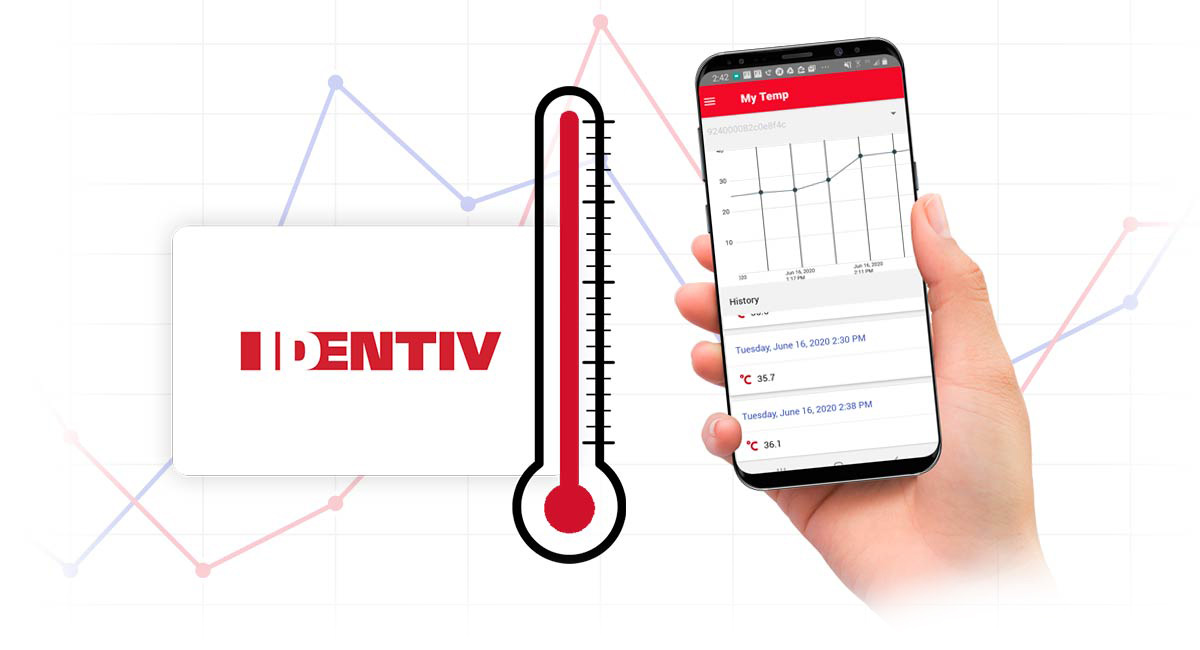RFID Journal: NFC Patch Takes Temperatures to Reduce COVID-19 Transmission
On June 19, 2020, RFID Journal’s Claire Swedberg discussed Identiv’s new body temperature measurement patch with Dr. Manfred Mueller, Identiv COO and GM, Identity. Here’s the story:
Approximately a dozen companies and government agencies are currently sampling a new temperature-monitoring patch from physical security and identification technology company Identiv. The system provides a user’s temperature via an app, with the tap of a smartphone. The Near Field Communication (NFC)-enabled Body Temperature Measurement Patch includes an NXP Semiconductors NTAG NHS Smart sensor chip, as well as an antenna, so that it can collect the temperature of an individual wearing the patch, then forward that data when interrogated by an NFC-enabled smartphone or other reading device.
Sample versions are being tested by entities representing three sectors, according to Manfred Mueller, Identiv’s COO and GM: federal governments, healthcare device manufacturers and systems integrators developing solutions for stadiums and other large public venues. The solution, designed to allow users to capture their own temperature readings wirelessly, consists of a patch that adheres directly to a person’s arm. Via a tag reader app on the user’s phone, an NDEF message is transferred which, in the current demo application, routes to an NXP server that then displays a website on the phone, along with the measured temperature.
Request a Free Sample
Request samples of the Identiv Body Temperature Measurement Patch.
Identiv is also developing a new version of an app that will be released within the next few weeks, the company reports. The technology is designed to offer an alternative to temperature readers installed at gates, which are not always precise, or handheld thermal devices that can scan individuals entering a restricted space. It would make temperature collection not only more accurate, Mueller says, but faster and less intrusive.
The patch is designed to wrap around a person’s upper arm, with the temperature sensor located near the armpit and the read point on the front of the arm. It comes with a non-irritant adhesive and can be attached like a Band-Aid bandage. The patch could potentially remain on the individual’s arm for several days or a week in its passive form, while in some cases users would only need to utilize it during a single event, such as when being admitted at a stadium’s entrance. “You simply tap on the antenna and it spits out the temperature,” Mueller explains. It has a temperature accuracy of about 0.3 degrees Celsius.
With regard to government adoption, the system could be used by health departments, for instance, to track the temperatures of quarantined individuals. If a person were to enter a country in which quarantining were mandated, he or she would be provided with a patch and instructed to download an app. The individual could then apply the patch and use his or her phone to access temperature readings at periodic times, such as once a day, so that the health department could monitor the person’s health.

The phone would typically need to be tapped within a few centimeters of the patch antenna on the arm in order to capture that data. Because the temperature data is automatically linked with the individual who downloads the app, a health office or other interested party could know when that individual may show symptoms of COVID-19 and man thus need to be visited or instructed to report to a hospital. Additionally, if the results indicated that person to be fever-free for a specified number of days, the health agency could determine that she or he met the quarantine requirements and can be released into the public.
Pharmaceutical and device manufacturers are also testing the technology to build into their own products. “Their innovation, engineering and business teams have reached out to us,” Mueller states, “and they are now evaluating the product.” If these companies developed a system for healthcare providers, the technology would make it possible for a patient home with a fever, or who has been exposed to COVID-19, to upload temperature data on a daily basis via the app so that the healthcare provider could view how that person was managing with the disease, based on the temperature information.
Read the original article via RFID Journal.